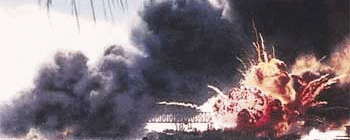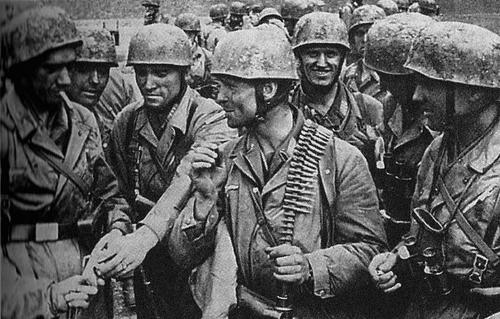World War Two Facts and Lists
When did World War Two Begin?
In Europe, World War Two began on September 1, 1939, when Germany invaded Poland. Three days later, France and Britain declared war on Germany, and on September 22, 1939, the Soviet Union invaded Poland from the east. The war in Europe grew to involve most nations in Europe, as well as European-controlled territories and nations in North Africa and the Middle East.
In Asia, Japan had begun its invasion of China in 1937, and some historians count that invasion as the start of World War Two, at least in the Asia/Pacific Theater. When Japan attacked, on December 7 and 8, 1941 (the United States at Pearl Harbor and the Philippines, the British at Hong Kong, Singapore, and Malaya, and the Dutch in what is now Indonesia), Japan and the United States, and most of east Asia and the Pacific region, entered World War Two.
When did World War Two End?
World War Two in Europe, ended with Germany’s surrender on May 7, 1945, a week after Hitler killed himself. The war in Asia and the Pacific ended on September 2, 1945, when Japan signed formal surrender documents. The war as a whole is considered to have ended with the surrender of Japan.
Who Won World War Two?
The coalition of nations commonly referred to as the Allies were the winning side. By the end of the war, the Allies were calling themselves the United Nations. The primary members of the Allies included: the United States, the United Kingdom, the Soviet Union, the Republic of China, France, Canada, Australia, New Zealand, and others.
What was the Axis?
The Axis was the alliance of nations that fought against the Allies in World War Two. The Axis consisted of Germany, Italy, and Japan as the major members, with minor members Hungary, Romania, and Bulgaria. The German and Italian client states of Slovakia and Croatia also were signatories of the Axis Pact of Steel. Thailand, Finland, and Iraq, and the Vichy French were co-belligerents on the Axis side, but were not members of the Axis Powers. Austria was part of Germany during the war and was occupied by Allied forces after the war in the same manner as Germany itself, and Austria had to sign a peace treaty in the 1950s that ended the military occupation. Albania and Libya were part of the Italian Empire during the war, and both became independent afterwards. Korea had been conquered by Japan prior to the war, and became independent afterwards, though as two separate and hostile nations.
Who were the Allies of World War Two?
The Allies consisted of dozens of nations. The following list shows each nation that engaged in major combat and the year they joined (some became Allies through being invaded by Axis Power nations).
Poland (from 1939-invaded by Germany)
United Kingdom (from 1939-declared war on Germany)-Note: the colonies and occupied nations of the British Empire, such as India and many areas in Africa and Asia, being under British control, were also part of the Allied Powers.
France (from 1939-declared war on Germany)-Note: the colonies and occupied nations of the French Overseas Empire, such as Algeria, and many areas in Africa and Asia, being under French control, were also part of the Allied Powers.
Canada (from 1939-declared war on Germany)
Australia (from 1939-declared war on Germany)
New Zealand (from 1939-declared war on Germany)
South Africa (from 1939-declared war on Germany)
Denmark (from 1940-invaded by Germany)
Norway (from 1940-invaded by Germany)
Belgium (from 1940-invaded by Germany)
Netherlands (from 1940-invaded by Germany)
Luxembourg (from 1940-invaded by Germany)
Greece (from 1940-invaded by first Italy, and then by Germany)
Soviet Union (from 1941-invaded by Germany and the other European Axis Powers)
United States (from 1941-attacked by Japan, declared war by Germany and Italy)
Commonwealth of the Philippines (from 1941-invaded by Japan; the Philippines were still controlled by the United States when the war began, but had elected its own government beginning in 1935 and was on the road to full independence when the war began)
China (at war with Japan from 1937, considered part of the Allies after Japan’s attack on the U.S. and Britain)
Ethiopia (at war with Italy and occupied from 1937, considered part of the Allies after Italy joined the war in 1940)
Mexico (from 1942, in response to German submarines sinking Mexican merchant ships)
Brazil (from 1942, in response to German submarines sinking Brazilian merchant ships)
In addition, several Axis nations changed sides and joined the Allies during the war:
Italy (from 1943-after a change in government after the Allied invasion of Italy)
Romania (from 1944-after being invaded by the Soviets)
Bulgaria (from 1944 -after being invaded by the Soviets)
Finland (from 1944-after making peace with the Soviets, Finland attacked remaining German troops on their territory)
In addition, all nations conquered and occupied by Axis forces had some form of active military resistance that fought Axis troops. In some nations, such as Greece and Yugoslavia, multiple guerrilla groups formed to fight the occupation, but also engaged in fighting against each other on many occasions. China had been in the middle of a civil war between the Nationalist government and Communist rebels when Japan invaded in 1937. During the Sino-Japanese War, the rival Chinese factions both fought against the Japanese, but also still engaged in hostilities at times.


